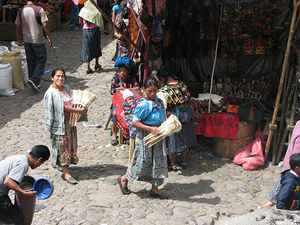ECLAC Analyses Small Countries of Central America
and the Caribbean

Photo: diskmix, Flickr
The small countries of Central America and the Caribbean face similar problems in their path towards sustainable development. Although their population sizes, economic structures and levels of development are very diverse, the states of Central America and the Caribbean share a number of characteristics in common, in particular, vulnerability to external shocks and events, which may be economic or meteorological.
Guatemala is the largest country in the group with 14 million inhabitants, and the smallest is Saint Kitts and Nevis with 47,000 inhabitants. In total, the region has around 75 million inhabitants according to data recorded in 2009.
A joint study prepared by ECLAC Subregional Headquarters in Mexico and Port of Spain, which will be published soon, deals precisely with the common limitations which the 22 small states of Central America and the Caribbean face in order to achieve sustainable development, and the policies needed to overcome these barriers.
The states of Central America and the Caribbean can be divided into two categories: those which are primarily exporters of services and those which are primarily exporters of raw materials and goods. However, the scale of their economies is small: their exports to Asia-Pacific, the United States of America and the European Union were not more than 3% of all shippings from Latin America in 2008.
The economies located in the Caribbean Basin have important links with the United States of America through trade, financial flows and remittances. Direct foreign investment in these small countries has grown exponentially since the 1990s, primarily from the United States of America, Spain, Canada and the United Kingdom.
In contrast to many developing countries, some states of Central America and the Caribbean show a desirable economic performance. However, they show characteristics which make them more vulnerable, such as economic openness, remoteness and isolation, exposure to natural disasters and environmental changes, limited diversification and capacity, poverty, and dependence on foreign capital.
Over the past decade, the figures for poverty and inequality in Central America and the Caribbean remained high despite the fact that the region achieved an average economic growth rate of 3%.
In its study, ECLAC examines macroeconomic and productive transformation policies needed to stimulate growth and equality in Central American and Caribbean countries, in addition to the possible sources of export diversification, among other important issues for the development of this region.
In order to build capacity and resilience against external shocks, it is advisable that Central American and Caribbean countries increase their human capital base by investing in health, education, science and technology.
Likewise, given their limited capacity, there is a need for a regional approach aimed at creating regional public goods which help the convergence process and the creation of useful strategies for increasing the integration of the countries into the global economy.
| The states of Central America and the Caribbean share a number of characteristics in common, in particular, vulnerability to external shocks and events, which may be economic or meteorological. | |
|
|
|
|
Over the past decade, the figures for poverty and inequality in
Central America and the Caribbean remained high despite the fact
that the region achieved an average economic growth rate of
3%. |
|